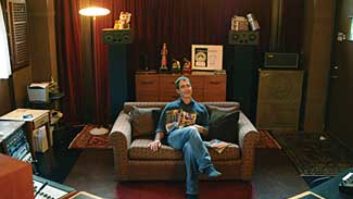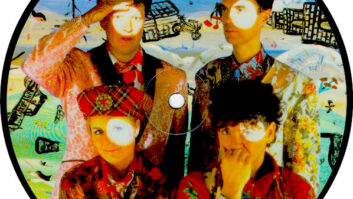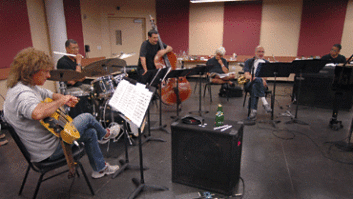
It seems like only yesterday that we gazed through the glass at Two Against Nature, the landmark comeback album for Steely Dan. Now, danmeisters Donald Fagen and Walter Becker — the enigmatic showbiz kids who consistently broke all the rules to create some of the coolest mainstream cult-pop on the planet — continue their ongoing tradition with the band’s latest release, Everything Must Go.
The album was recorded in a matter of months — an astonishing feat for a band previously known for releasing albums that took years to complete — yetEverything Must Go is strengthened by the experience. For this release, the Dan actually cut live, basic tracks with a real band rather than with sonic-assemblage techniques, using dozens of session players and scrupulously replaced sounds. And for a band hailed for their forays into cutting-edge technologies, Everything Must Go is in many ways a return to their roots, with tight, hook-laden songs recorded with the warmth of tape and a vibe that evokes the best of Steely Dan’s earlier works.

Everything Must Go includes a number of elegant touches. Becker returns to play bass with the band and steps up with overdubbed guitar solos on five of the nine tracks. And for the first time since his brilliant — but critically ignored — 11 Tracks of Whack solo album (1994), we actually hear Becker sing, marking his SD vocal debut on “Slang of Ages,” with its trés cool “Spill the Wine”-style groove.
Everything Must Go is a stronger album than the Dan’s quadra-Grammy™ Award-winning Two Against Nature. The production is more relaxed and natural-sounding; overall, the songs are better crafted, creating a more consistent package. And like other Becker/Fagen creations, Everything Must Go doesn’t immediately grab one by the throat, but after a couple of plays, the infectious hooks on tunes such as “GodWhacker,” “Pixeleen,” “Things I Miss the Most” and the two single pulls (“The Last Mall” and “Blues Beach”) are firmly locked into the listener’s consciousness.
Thanks to the magic of $1.49/song downloads, the singles were made available a month before the album’s official release, and thousands of eager SD fans responded to the call. This, of course, was followed by a deluge of Internet postings by fans who endlessly debated the meanings (and/or actual wordings) of the lyrics. Speaking of the release, Everything Must Go simultaneously came out on CD-Audio, DVD-Video, DVD-Audio and in a European limited release on 12-inch vinyl.
In his January 2003 Mix interview, Everything Must Go engineer Elliot Scheiner spoke briefly about the project, but for more details, we talked to Becker and Fagen, who offered their insights into the new release.
What was your overall direction forEverything Must Go?
Fagen: We were trying to stretch our apocalyptic aspect a little further than it’s been for a while. This is a good time for that, with us being in the early 21st century and all that.
The Nightflyfocused on the past. This one’s focused on the future.
Fagen: In a certain way. This is the security century, which brings up a whole host of fears. Fears and desires…
Haven’t those been recurring Steely Dan themes?
Fagen: It has, but somehow, this time it seems to have crystallized in 2003. It feels like the century’s chasing us, like having a hellhound on your trail.
Well, hopefully we’re not all heading into “The Last Mall.”
Fagen: Hopefully not, but these are the fears that need to be expressed. People are usually afraid to say what’s on their mind.
Everything Must Gosounds like a return to the classic Steely Dan sound of old. For example, “Blues Beach” has kind of a “My Old School” vibe.
Becker: I hadn’t thought of that before, but I can see why you’d say that.
Fagen: It has kind of a frat house feel…
Becker: …a rollicking, major-key, playful cadence and feel to it.
Where did you record the album?
Becker: We tracked at Sear Sound in New York, did most of the overdubs at Skyline Studios in New York, and other overdubs were done at my place in Hawaii and at Sear. We mixed at Presence Studios in [Westport] Connecticut.
Did Elliot Scheiner do all of the tracking and mixing?
Fagen: He did only tracking and mixing.
Becker: We had other engineers — Roger Nichols, T.J. Doherty and Dave Russell — who work at my studio in Maui.
Fagen: You know, there was a George Russell, an Irish poet who went by the pretentious pen name AE…
Becker: Is that true?
Fagen: Yes, and there was also the great jazz composer George Russell, who also wrote the Lydian theory of chromatic tonal organization.
The tracking was with a live band in one room?
Becker: The basics for each track were cut in one day with the band.
Fagen: All of our guys actually sat in a room together and played, like an old-fashioned band.
That’s an amazingly advanced concept!
Becker: We thought so.
Fagen: It’s also the technique of the future. “There’s no time like the future to get something done,” as Robert Heinlein once said.
And rightly so! But who’s in the band this time?
Fagen: On drums, it was Keith Carlock. Hugh McCracken and John Herrington played electric guitars, Walter played electric bass, I played electric or acoustic piano, Ted Baker played keyboards, too.
Becker: On one occasion, when Ted was out of the country, jazz musician Bill Charlap came in as the second piano player.
After years of working in digital,Everything Must Gomarks your return back to analog.
Becker: We went forward to analog!
Fagen: Analog is the medium of the future!
Becker: We ended up using analog because we started working at Sear Sound and we loved the studio so much and they only had analog machines there.
Fagen: Walter Sear, the studio owner, is deeply into gear you might call “retro,” but since it never really went out, how could it be retro?
After putting the basics down, did you go to a workstation environment for overdubs and editing?
Becker: We then went to Sony PCM-3348HR…
Fagen: [sings blues] I went down to the workstation. I walked down to the workstation!
Becker: With an occasional foray into a workstation. Most of the time, we…
Fagen: [continues to sing the blues] And met my Jesus there…
Becker: And met my digital Jesus there.
Fagen: This connects to some of that “GodWhacker” material.
Becker: This is a sort of theological…
Existentialism?
Fagen: Essentialism, really…
Becker: So where were we?
I was asking about workstations.
Becker: We did all of the work recording overdubs on the Sony machine.
Elliot is a big Nuendo fan. Were the workstation parts done in that or Pro Tools?
Becker: We’ve worked in Pro Tools in the past, and I had never worked in Nuendo. And although Elliot kept telling us how great Nuendo was, there were Pro Tools systems everywhere, so we did some work in Pro Tools.
So did the analog recording account forEverything Must Go‘s smoother sound?
Becker: It’s partly analog, partly fortuitous and partly Elliot. He’s got taste, and what he does is very distinctive.
What format did you mix to?
Becker: We came out of the Neve [at Presence] and went to analog tape and also to an Alesis Masterlink, fed by some high-res outboard converters.
Did you record 15 or 20 songs or just nine?
Becker: We had two good tracks left over, along with some partial songs and false starts…
Fagen: One was too slow and draggy. The other was too fast.
How is that you guys manage to keep such a consistent sound using so many musicians in different studios during the years?
Becker: By now, the new musicians have heard all of our old records and they fall right into it.
Part of that consistency comes from the horn parts and arrangements. Who did them?
Fagen: I do them, but Walter helps, as well. I used to listen to a lot of Oliver Nelson records in the ’60s, and I like Thad Jones’ arrangements, but really it’s homemade. I never really studied horn arranging, so I just make it up.
So you go into the studio with all of the finished charts written up?
Fagen: Pretty much; sometimes, we do a little rewriting in the studio, but I write them out in advance, with the voicing and general layout.
Does that also apply to backup vocals and harmonies?
Becker: A lot of those are just done all at once. We figure them out on the piano in the studio. We usually use close-voicing, like everybody else in the rock ‘n’ roll world, but as the chords are more interesting, we get some interesting dissonances.
OnEverything Must Go,Walter’s back to playing bass. It’s kind of a return to the old Steely Dan days.
Becker: Yeah. It was a real flashback and I’d almost forgotten how much fun it was to play the bass and what a great job it is to play bass in a band full of great players. Actually, the reason I stopped was back in the L.A. days in the ’70s, the players were getting a little too hot for me. I remember sitting in a room playing with Jim Gordon and Michael Omartian and Dean Parks, and I realized that someone else should be sitting in that chair, and his name was Chuck Rainey. Nowadays, Chuck lives in Dallas, so I’ve been playing the bass again, and what we’re trying to do musically is a little different, so it lends itself to me playing bass again. I loved doing it. It was great.
On “Slang of Ages,” we finally hear Walter Becker singing on a Steely Dan album.
Becker: For years, I’ve been offering to sing a song, knowing full well that I’d avoid it at all possible costs. And due to the range difference between Donald and myself, I could never sing on one. But on the track we’d cut for “Slang of Ages,” the verse was a free verse and I could sing the chorus melody down one octave, so I could actually sing a song that had been meant with Donald in mind.
This whole thing was an accident?
Becker: It was originally meant for Donald, but when we got down to it, I realized I could sing it and felt I should do a share of the work, because singing is a huge proportion of the studio time. Another way that “Slang of Ages” was suited more to me than Donald was because it doesn’t have a written melody for the verse and Donald doesn’t like doing songs that are like that. I ended up doing it because I could, and I should if I could.
Will there be more Walter Becker vocals on the next album?
Becker: Not if I can help it, because Donald is a much better singer than me. His style and his range and approach is a large part of the band’s characteristic sound. He’s the frontman; I’m the guy behind the guy.
What are some of your feelings about surround sound and high-res release formats?
Becker: Regarding surround sound, I know musicians too well to want them behind my back. But because of the additional speaker separation, the surround mixes I’ve worked on can make 2-channel sound somewhat low-fi by comparison. But I still prefer stereo overall. The music holds together better.
It’s funny, but as the sonics improve, the focus on music doesn’t improve. For example, there are a lot of ways to record piano, and a lot of people do much better piano recordings than Rudy Van Gelder ever did. But when you listen to a Van Gelder piano recording, you’re listening to the sound of the guy’s piano and the notes in his solo. When you listen to more hi-fi recordings of pianos, you might hear more high-end detail and clarity, but you may be listening more to the overtones of the piano and less focused on the intention of the musician, which is in the fundamental pitches of the notes, rather than the often-clangorous overtones.
That’s one thing I’ve noticed with a lot of modern musicians who are sometimes more concerned with the sound of the patch or setting than the overall performance. If you sat Ray Charles down on a Rhodes piano, magic could happen. And if you sat Chick Corea down in front of that same piano, it’s a completely different — yet wonderful — sound.
Becker: I remember going to a concert at Hunter College when I was a teenager in New York. There was a jazz pianist named Billy Taylor — who was also a promoter and DJ — and he had a show with himself, Mary Lou Williams and Thelonious Monk. One after another, they sat down and played the same piano and it was amazing how different the piano sounded. In fact, when Monk played, it didn’t even sound like a piano anymore! It’s the same with guitar, drums and anything else. I think that’s one of the unfortunate by-products of the fascination with and proliferation of technologies now: It’s essentially a distraction from music and its fundamental aesthetic considerations.
Everything Must Gomust be one of your fastest album productions ever.
Fagen: We’re not getting any younger…
Becker: …And we don’t want our next album to be finished by our estates!
We’re almost out of time. Do you have anything else to add?
Fagen: Don’t buy a hat through the mail!
Mix editorial director George Petersen is also the co-author of Crazy Campsongs (www.crazycampsongs.com), a slightly whacked collection of sing-alongs for modern society.





